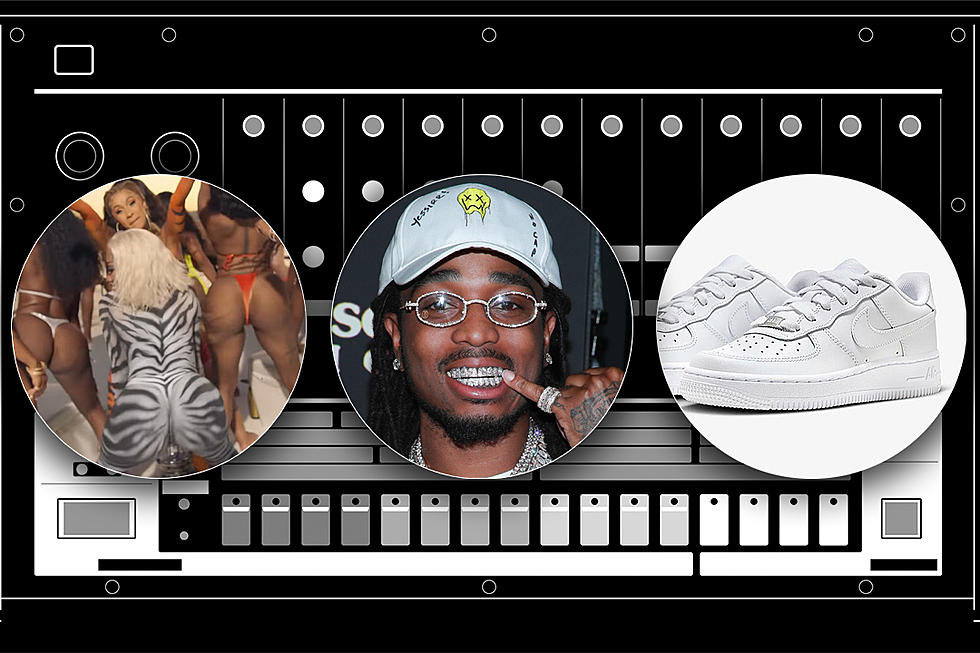![Wu-Tang Clan, “It Don’t Stop” [Excerpt From the July/August 2012 Issue]](http://townsquare.media/site/812/files/2012/07/WuTang%252BClan%252B9%252BMilli%252BBros.jpg?w=980&q=75)
Wu-Tang Clan, “It Don’t Stop” [Excerpt From the July/August 2012 Issue]
WORDS DAVE BRY
IF YOU THINK ABOUT WHAT NEW YORK CITY RAP WAS LIKE 15 YEARS AGO, IN 1997, CHANCES ARE YOU’RE THINKING ABOUT disco beats and designer clothes and champagne and mirror balls. Sean "Puffy" Combs and Bad Boy Records showed amazing resilience in the wake of Biggie Smalls’ murder, “partying through the pain,” as Shaheem Reid wrote in this magazine six months ago, holding the top spot on Billboard’s Hot 100 singles chart for 22 weeks out of the 52 in the year and assembling Jay-Z, Busta Rhymes, Nas, Foxy Brown and others for the victorious No Way Out Tour. It was a fly, fabulous, glittery pop moment, reflective of the country’s burgeoning economic boom, the height of the “shiny-suit era.”
But there is another story, one that’s been buried a bit by the sands of time. A shadow history.
For a certain type of rap fan, in certain parts of the city, darker, smokier parts, places that didn’t smell so nice, perhaps, where the dresscode leaned more toward army fatigues and Timberlands, and the people that wore them leaned more toward the floor, 1997 represented something else: the pinnacle of a different era. A last stand of sorts, maybe, but a proud one. For hip-hop fans less inclined to dance to Puffy’s repurposing of 1980s R&B hits, 1997 marked the reformation and return of the greatest group in rap music history: 1997 belonged to the Wu-Tang Clan.
In the face of the trends of the day, the nine-man outfit’s second album, a 27-song, one-hour-and-52-minute-long opus called Wu-Tang Forever, was a dark, sprawling, uncompromising statement of purpose: Hip-hop should not be shiny. It should be grimy.
“This ain’t no R&B,” group leader The RZA says on the intro of the second disc. “With a wack nigga takin’ a loop, reloopin’ that shit, thinkin’ it’s gonna be the sound of the culture.”
“All that playa bullshit...” Masta Killa pipes in. “All that playa, dressin’ up, actin’ like this is some kinda fashion show, man. You know what I’m sayin’? This is hip-hop right here...”
The album puts those words into fuzzed-out bass drones and a hive’s worth of swarming synth strings, the music sounds anxious, worried, bristling with premillennium tension. Low on melody, highly vulgar, dense with labyrinthian, stream-of-consciousness lyrics and songs that clock in closer to five minutes than three, it seems almost purposefully engineered not to get played on the radio. Wu-Tang Forever is hip-hop as high art, unapologetically.
TO READ MORE ON THE IMPACT OF WU-TANG FOREVER, GO TO THE NEXT PAGE
I don’t mean to overstate the case. Wu-Tang Forever is not a perfect rap album. At the time, in the fever of the moment, certain overenthusiastic Wu fans made the claim that it was in fact a better work than both Biggie’s Life After Death, and the first Wu-Tang album, 1993’s Enter the Wu-Tang (36 Chambers). I was one of these fans. With the benefit of hindsight, I feel differently. Forever is cluttered, unfocused, self-indulgent and, like so many double albums, overlong (and so can seem aptly, and unfortunately, titled). Someone should have stepped in and convinced the guys that while “Black Shampoo” may be a good song title, the song itself would've been better left on the shelf.
But on the other hand, we wouldn’t have wanted that. Paradoxically, the album’s flaws are a part of its greatness. The sound of the album is the sound of artists experimenting, exploring, challenging listeners and trusting that they’ll open their ears and follow them to new musical terrain. Sure, a little drunk on the fruits of their discovery (and a lot stoned on the custom-concocted honey-dipped blunts that The RZA favored at the time), but exhilarating in the freedom that a lack of editing and a disregard for concerns about accessibility provide for. Coming on the heels of three unmitigated hip-hop classics, the debut solo albums from group members Raekwon, The GZA and Ghostface Killah, Wu-Tang Forever is the sound of being in full control of one’s world, of being able to do absolutely whatever you want in the studio, and doing it.
It really is The RZA’s album, too. While it’s notable for being the first Wu-Tang Clan LP to include tracks produced by his apprentices 4th Disciple and True Master, Forever, as much as any Wu project, bears the mark of the original leader’s distinctive sensibility—one tinged with Black-nationalist superhero fantasy, apocalyptic paranoia and Eastern mysticism. The second-to-last song on the album, “Second Coming,” contains no rapping, just vocalist Tekitha singing modified lyrics to the tune of Jimmy Webb’s “Macarthur Park,” record made most famous by Donna Summer. But with its dirge-like beat and gloomy atmospherics, with spooky keyboard notes that float up off the track like a circular staircase in a mist-shrouded monastery, there could be no mistaking the singular musical vision behind it. And no mistaking it for anything anyone would get mixed up with R&B.
***
The choice of singles released from the album further evidences a refusal to compromise. Heralding the advance was “Triumph,” a five-minute, 38-second verbal workout wherein all nine Wu-Tang MCs take their turns in the spotlight—as well as associate member Cappadonna. There’s no chorus, or even anything that might be called a hook. Just lyrics, lyrics and more lyrics, over a relentless bass drum and a dizzying swirl of strings. “It’s Yourz,” the second single, features a B-boy-era break beat and a chorus, but a monotone, chanted one, more at a home at a military rally or a football game than on a Top 40 station. And the third, “Reunited”—a masterpiece constructed out of acoustic guitar notes and zigzag violins, with backup singer Roxanne putting a sweet, teasing croon to the repeated refrain, “It’s Wu, muthafuckas...Wu-Tang, muthafuckas”—sounds very unlike anything that anyone had ever heard before. Still, a testament to die-hard fan loyalty and the power of grassroots marketing, the album sold more than 600,000 copies its first week in stores—and went on to top the 2 million mark.
With the album’s proud embrace of outsider status, raising a fist against the pop trends of the day, and its smoked-out weirdness, it makes sense that Wu-Tang Forever would appeal to the “alternative music” crowd. But back then, in 1997, the announcement that Wu-Tang would embark on a nationwide, 28-city stadium tour with hyper-political thrash rockers Rage Against the Machine seemed, if not quite revolutionary, surprising and bold in its ambition. “Most tours these days are put together on the assumption that audiences only like one kind of music,” J.D. Considine wrote in the Baltimore Sun. “What the Rage/Wu-Tang tour hopes to prove is that rock fans will listen to rap, and vice versa. That the tour is packing amphitheaters across the country testifies to the accuracy of that assertion.”
It was a little too ambitious, it turned out, as Wu-Tang dropped off the tour after 15 shows due to internal discord. But the tour proved their appeal to the rock crowd, setting a precedent for the rap-rock amalgam that groups like Korn and Limp Bizkit would find such huge success with, and Wu-Tang members find a healthy audience within collegiate and hipster circles to this day.
TO READ THE FULL STORY ON WU-TANG CLAN'S WU-TANG FOREVER, PICK UP XXL'S 2012 JULY/AUGUST ISSUE. IN STORES NOW!
More From XXL









